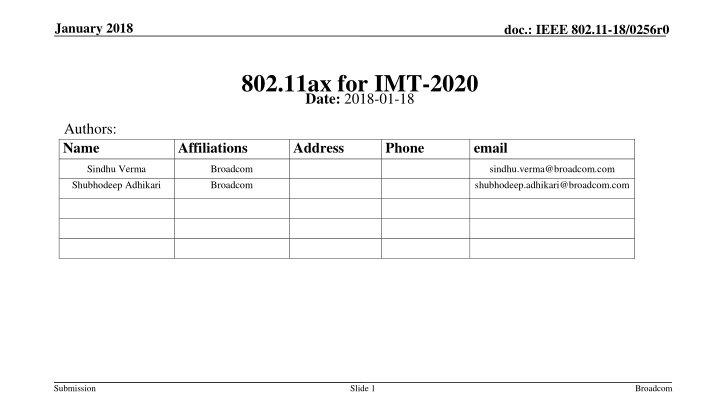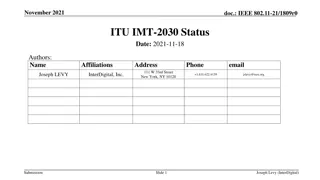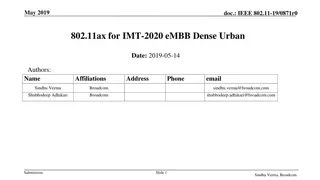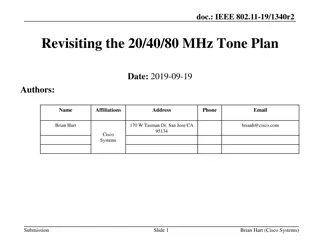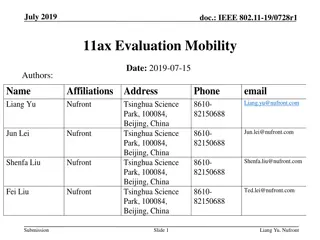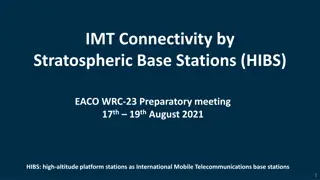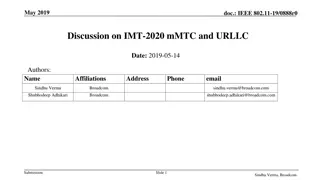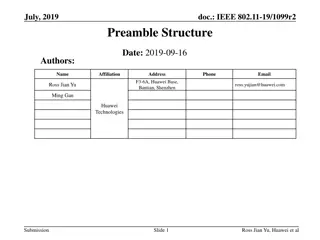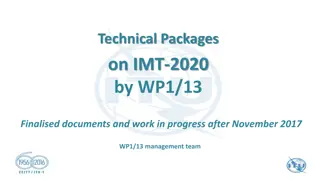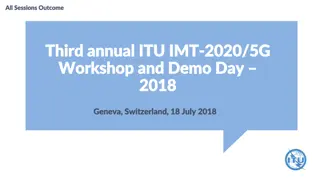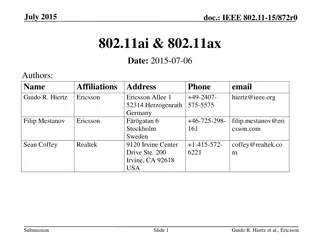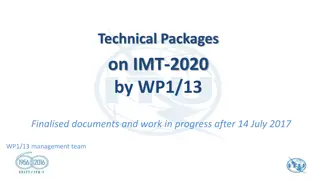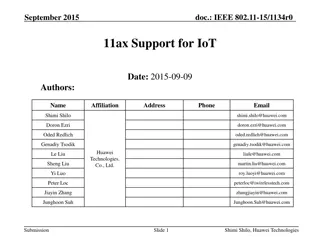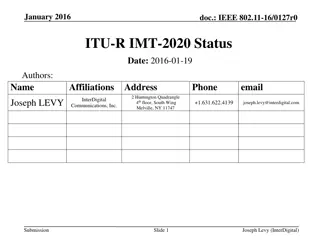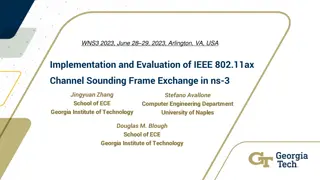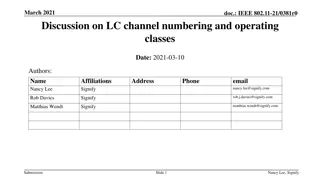Analysis of 802.11ax Capabilities for IMT-2020 Requirements
This document analyzes the capabilities of 802.11ax in meeting the requirements of IMT-2020 for scenarios like eMBB Indoor Hotspot and Dense Urban, comparing features with technologies such as LAA and MulteFire. It also discusses how 802.11ax aligns with proposed features in NR-Unlicensed to fulfill IMT-2020 requirements.
Download Presentation

Please find below an Image/Link to download the presentation.
The content on the website is provided AS IS for your information and personal use only. It may not be sold, licensed, or shared on other websites without obtaining consent from the author.If you encounter any issues during the download, it is possible that the publisher has removed the file from their server.
You are allowed to download the files provided on this website for personal or commercial use, subject to the condition that they are used lawfully. All files are the property of their respective owners.
The content on the website is provided AS IS for your information and personal use only. It may not be sold, licensed, or shared on other websites without obtaining consent from the author.
E N D
Presentation Transcript
January 2018 doc.: IEEE 802.11-18/0256r0 802.11ax for IMT-2020 Date: 2018-01-18 Authors: Name Affiliations Address Phone email Sindhu Verma Shubhodeep Adhikari Broadcom Broadcom sindhu.verma@broadcom.com shubhodeep.adhikari@broadcom.com Submission Slide 1 Broadcom
January 2018 doc.: IEEE 802.11-18/0256r0 Abstract This document provides an analysis of 802.11ax capabilities vis- -vis the IMT-2020 requirements for the eMBB Indoor Hotspot and Dense Urban scenarios. It also discusses the features in other unlicensed spectrum technologies like LAA and MulteFire. It also discusses 802.11ax features with the proposed features in NR- Unlicensed in order to meet the IMT-2020 requirements. Submission Slide 2 Broadcom
January 2018 doc.: IEEE 802.11-18/0256r0 802.11ax vs. IMT-2020 requirements 802.11ax capability Parameter Desired Range Use Case 19.2 Gbps DL/UL (8x8 HE160) Peak data rate DL/UL: 20/10 Gbps eMBB 60 bits/s/Hz (8x8) Peak spectral efficiency DL/UL: 30/15 bits/s/Hz eMBB DL/UL: 0.3/0.21 bits/s/Hz DL/UL: 0.225/0.15 bits/s/Hz eMBB: Indoor Hotspot eMBB: Dense Urban Expected to Meet 5%ile user spectral efficiency Expected to Meet 5%ile user experienced data rate DL/UL: 100/50 Mbps eMBB DL/UL: 9/6.75 bits/s/Hz/TRxP DL/UL: 7.8/5.4 bits/s/Hz/TRxP eMBB: Indoor Hotspot eMBB: Dense Urban eMBB: Indoor Hotspot eMBB: Dense Urban eMBB URLLC Expected to Meet Avg Spectral efficiency Expected to Meet Area traffic capacity 10 Mbps/m2 4 ms 1 ms Can meet User Plane Latency Can meet for STA initiated Control Plane Latency 20 ms (Encourage 10 ms) eMBB/URLLC Not in focus for eMBB Connection density 106 connected devices/km2 mMTC Efficient data transmission in high loads Low energy consumption in absence of data High sleep ratio and long sleep duration 1-10-5 success probability for transmitting a Layer 2 PDU within 1ms at coverage edge for Urban Macro-URLLC 1.5 bit/s/Hz UL @ 10 kph 1.12 bit/s/Hz UL @ 30 kph Can meet Energy efficiency eMBB Not in focus for eMBB Reliability URLLC eMBB: Indoor Hotspot eMBB: Dense Urban Can meet Mobility (defined only for UL) ~ 2-3 ms Mobility Interruption Time 0 ms eMBB and URLLC 160 MHz Bandwidth Scalable: Min 100 MHz, up to 1 GHz Submission Slide 3 Broadcom
January 2018 doc.: IEEE 802.11-18/0256r0 802.11ax vs. LAA/MulteFire 802.11ax Feature MuLTEfire / (e)LAA Comments regarding 802.11ax Highest modulation 1024-QAM 256-QAM 25 % higher peak data rate Guard Interval length 0.8us, 1.6us and 3.2 us 4.69 us (fixed) Flexible and dynamic adaptation of Guard Interval to suit the current operating environment Symbol length 13.6 us,14.4 us,16 us 71.4 us Shorter symbol length => Shorter RTT Common Features Minimum transmission length O(50) us 1 ms Finer control of transmission lengths => less padding => more efficient medium usage Starting transmission granularity 9 us 0.5 ms (DL), 1 ms (UL) Ending transmission granularity 13.6 us,14.4 us,16 us 214 us (DL), 1 ms (UL) Maximum transmission bandwidth 80 + 80 MHz or 160 MHz 80 MHz (unlicensed), 100 MHz (including licensed) Higher transmission bandwidth OFDMA Yes Yes Comparable with respect to OFDMA/MU-MIMO/Beamforming. However 11ax supports higher bandwidth and higher modulation leading to higher data rates DL MU-MIMO Yes Yes Beamforming Yes Yes OFDMA + MU-MIMO Yes Yes Maximum transmission bandwidth 80 + 80 MHz or 160 MHz 20 MHz (unlicensed), 60 MHz (including licensed) OFDMA Yes Yes (SCFDMA) 11ax UL supports higher bandwidth, MIMO with higher number of spatial streams, MU-MIMO and better beamforming. MIMO Yes, up to 8 spatial streams Yes, up to 4 spatial streams UL MU-MIMO Yes (up to 8) No Beamforming Yes, fixed and implicit codebook as DL Yes, only with fixed codebook OFDMA + MU-MIMO Yes No Higher UL PSD Yes Slide 4 Yes Submission Broadcom
January 2018 doc.: IEEE 802.11-18/0256r0 802.11ax vs. NR-Unlicensed Standardization of NR-Unlicensed (NR-U) will start in Feb/2018. The following table describes a possible list of features in NR-U which are enhancements over LAA. These have been compiled from submissions to 3GPP, NR-U workshops in 2016 and 2017. NR-U specification does not yet exist. So, the potential feature list is hypothetical. It is noted that numerous official contributions in 3GPP and other fora cite the performance advantage of specific features in 802.11 to argue for similar features in NR-U. Some of these documents are included as reference. It is expected that NR-U will incorporate principles similar to 802.11 in order to close/reduce the performance gap, especially in uplink. It is noted that many NR-U proponents oppose significant changes to NR-U over NR-licensed in order to reduce design complexity. So, there is a strong possibility that NR-U may not be as flexible as Wi-Fi. Submission Slide 5 Broadcom
January 2018 doc.: IEEE 802.11-18/0256r0 802-11ax vs. NR-Unlicensed Proposed NR-U Enhancements over LAA/MF 802.11ax Capability Standalone unlicensed operation Yes Operation in 5.0-7.1 GHz, 37-37.6 GHz, 57-71 GHz Yes (5.0 7.1 GHz) Scalable bandwidths, up to 400 MHz per component carrier (400 MHz for 240 kHz carrier spacing and high frequencies) Scalable up to 160 MHz Self-contained TXOP for faster turn-around Yes Short flexible symbol durations for lower latency Yes (3.6us/4us/13.4us/14.4us/16us)/similar to shortest NR symbols Front loaded reference signals for faster demodulation Yes Mini-slots for quick and short Tx-Rx exchanges and for channel contention and reservation Yes (16 us RTT)/Faster than NR requirement Grant-free UL transmission Yes Variable DL/UL split for dynamic TDD Yes Improved/updated CCA: Channel reservation optimized for high-order MIMO and mmW bands: Spatially directional channel sensing and reservation Omni-directional/Directional CCA for Tx w/ directional beam Signaling-based medium reservation: (W/in+across RATs) Universal signaling for channel reservation Yes, except universal signaling for channel reservation across RATs, which is TBD between standards bodies Better support for neutral host deployments Yes Submission Slide 6 Broadcom
January 2018 doc.: IEEE 802.11-18/0256r0 Discussion 802.11ax already meets most of the IMT-2020 requirements for eMBB Indoor Hotspot and Dense Urban use cases. The gaps in the remaining few requirements for these two use cases are narrow. It is more difficult for 802.11ax to meet the requirements for eMBB Rural due to the higher mobility criteria. A possible Way Forward is to change scope and prioritize the requirements for eMBB Indoor and Dense Urban. It will enable 802 take the position that 802.11ax is proven to satisfy all the requirements for these two important IMT-2020 use cases and let 802.11ax gain significant branding advantage. Submission Slide 7 Broadcom
January 2018 doc.: IEEE 802.11-18/0256r0 References [1] Qualcomm: Radio Access Design [2] Qualcomm: Gap analysis for standalone operation from licensed assisted system definition [3] Samsung: Radio Access Design (Samsung_AI_3.pdf) [4] Nokia: Radio Access Design [5] Intel: Gap analysis for standalone operation from licensed assisted system definition [6] LG: Radio Access Design [7] Ericsson: Views on NR Unlicensed operation designs [8] 3GPP TS 36.211, 36.213, 36.300 for LTE/LAA [9] 3GPP TS 38.211, 38.213 for NR [1] [7] were presented at the 5G Workshop on NR-Unlicensed and Shared Spectrum Submission Slide 8 Broadcom
